Brush Traction was a manufacturer and maintainer of railway locomotives in Loughborough, England whose operations have now been merged into the Wabtec company's Doncaster UK operations.

The National Tramway Museum is a tram museum located at Crich, Derbyshire, England. The museum contains over 60 trams built between 1873 and 1982 and is set within a recreated period village containing a working pub, cafe, old-style sweetshop and tram depots. The museum's collection of trams runs through the village-setting with visitors transported out into the local countryside and back and is operated by the Tramway Museum Society, a registered charity.

Sheffield Tramway was an extensive tramway network serving the English city of Sheffield and its suburbs.

A double-decker tram or double-deck tram is a tram that has two levels or decks. Some double-decker trams have open tops. Double-deck trams were once popular in some European cities, like Berlin and London, throughout the British Empire countries in the early half of the 20th century including Auckland, Christchurch and Wellington in New Zealand; Hobart, Tasmania in Australia and in parts of Asia. They are still in service or even newly introduced in Hong Kong, Alexandria, Oranjestad, Blackpool, Birkenhead, Franschhoek, Auckland and Douglas, mostly as heritage or tourist trams.

The Grimsby & Immingham Electric Railway (G&IER) was an electric light railway, primarily for passenger traffic, linking Great Grimsby with the Port of Immingham in Lincolnshire, England. The line was built by the Great Central Railway (GCR), was absorbed by the London & North Eastern Railway (LNER) in 1923, and became part of the Eastern Region of British Railways. It ran mainly on reserved track.
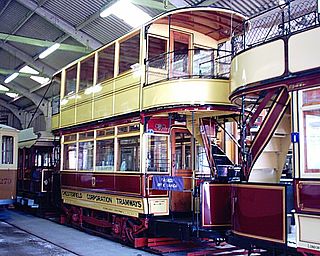
The Chesterfield and District Tramways Company and its successors ran a tramway system in the Derbyshire town of Chesterfield, England. The first horse-drawn line opened in 1882, and in 1897, the system was taken over by Chesterfield Corporation, who extended and electrified it in 1904 and 1905. Additional tramcars were purchased, but two had to be scrapped after a disastrous fire at the depot in 1916. The system suffered from a lack of maintenance as a result of reduced staffing levels during the First World War, and the trams were replaced by trolleybuses in 1927.
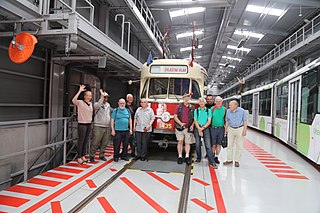
The Scottish Tramway and Transport Society was founded on 27 June 1951 and was the firsty society in the United Kingdom dedicated to tramway retention and preservation. Until 1983 it was known as the Scottish Tramway Museum Society. The Society was originally formed by tramway enthusiasts, mainly living in the Glasgow area, with a view to preserve a Glasgow "Room and Kitchen" type single deck tramcar No. 672 of 1898. The Society was less successful in attempting to preserve an Aberdeen tram. Tram 73 was Aberdeen's last double deck tram with an upper-deck balcony; it was stored for two years until lack of resources led to its scrapping in 1956.
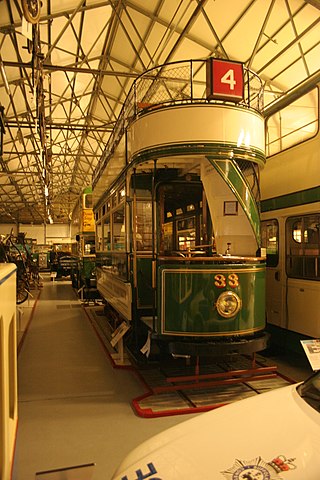
The Ipswich Transport Museum is a museum in Ipswich, Suffolk, England, devoted principally to the history of transport and engineering objects made or used in its local area.

The W-class trams are a family of electric trams built by the Melbourne & Metropolitan Tramways Board (MMTB) between 1923 and 1956. Over the 33 years of production, 752 vehicles spanning 12 sub-classes were constructed, the majority at the MMTB's Preston Workshops.
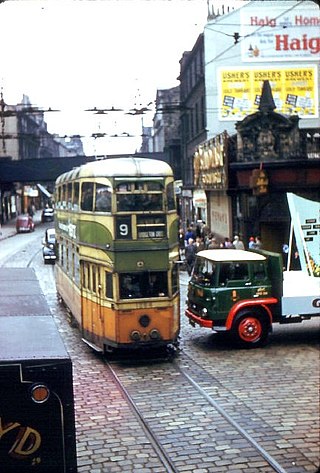
Glasgow Corporation Tramways were formerly one of the largest urban tramway systems in Europe. Over 1000 municipally-owned trams served the city of Glasgow, Scotland, with over 100 route miles by 1922. The system closed in 1962 and was the last city tramway in Great Britain.

Leeds Corporation Tramways formerly served the city of Leeds, England. The original trams were horse-drawn, but the city introduced Britain's first overhead-powered electric trams in 1891, and by 1901, electrification had been completed. The tramway opened on 29 October 1891.
Edinburgh Corporation Tramways was a Scottish tram network that formerly served the City of Edinburgh, Scotland. The city used four-wheeled double-decked trams painted dark red (madder) and white – a livery still used by Lothian Buses and the modern light rail Edinburgh Trams.

Hurst, Nelson and Company Ltd was a railway rolling stock manufacturer based in Motherwell, Scotland. The company also built many railway wagons, as well as trams and trolleybus carosseries for several local authorities.

The Adelaide trolleybus system formed part of the public transport network in Adelaide, South Australia from 1932 until 1963.

Dundee and District Tramways operated a tramway service in Dundee between 1877 and 1899.

The Blackpool and Fleetwood Tramroad operated a tramway service between Blackpool and Fleetwood from 1898 to 1920.

The English Electric Balloon is a type of double-decker tram that is operated on the Blackpool Tramway. Initially brought into service in 1934, the Balloon formed the backbone of the Blackpool tram fleet until the tramway's conversion to a modern light rail network in 2012. Following the network's re-opening, nine Balloons were converted to meet the disability regulations to serve as a supplement to the modern Flexity 2 vehicles. Some of the Balloons have been retained for use within the heritage fleet.
Bradford Corporation Tramways were a tramway network in the city of Bradford, West Riding of Yorkshire, England which operated trams from 1882 until 1950 and trolleybuses from 1911 until 1972. The track gauge of the tramways was 4 ft.
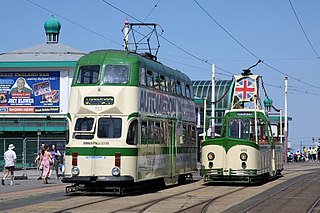
Blackpool Heritage Trams are a mixed fleet of restored vehicles that run on the Blackpool Tramway, which runs from Blackpool to Fleetwood on the Fylde Coast in Lancashire, England. The line dates back to 1885 and is one of the oldest electric tramways in the world. It is operated by Blackpool Transport (BT) and is the last surviving first-generation tramway in the United Kingdom. Excluding museums, it is one of only a few tramways in the world to still use double-decker trams.
















